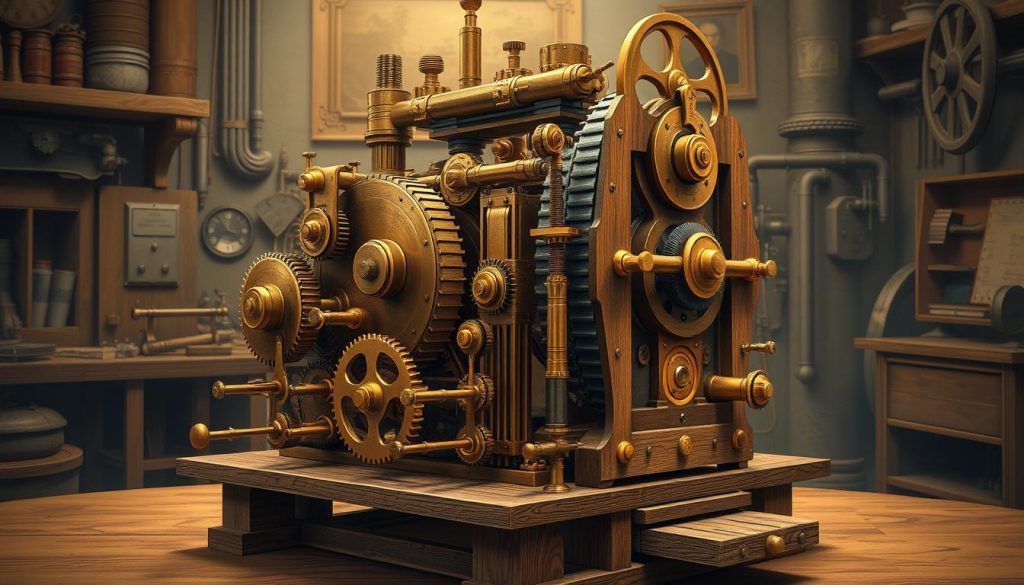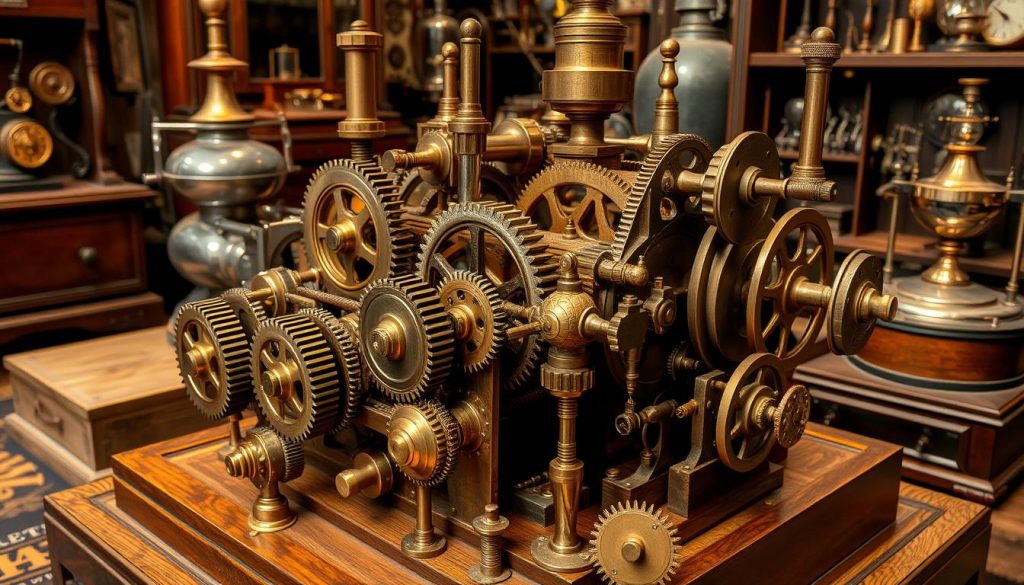Charles Babbage’s difference engine: The ancestor of the modern computer.
Charles Babbage’s Difference Engine was a major step in computer history. Built in the 1820s and ’30s, it was meant to simplify complex math tasks. Babbage wanted to make a mechanical calculator that could quickly and accurately create math tables.
Anúncios
This innovation was a big deal for math and set the stage for today’s computers. It showed how machines could do math tasks that were once too hard for humans.
Charles Babbage’s work on the Difference Engine won him a gold medal from the Royal Society in 1823. He aimed to fix errors in navigation tables that were crucial for sailors. The Difference Engine was a big step forward, making it easier to do complex math tasks.
The Difference Engine used decimal digits, unlike today’s binary system. It was meant to be huge but was never fully built by Babbage. Still, it’s a key part of computer history and inspired many future inventions.
Anúncios
The Vision Behind Babbage’s Difference Engine
Charles Babbage was a leading figure in computing. He dreamed of a machine that could do math tables automatically. This was to cut down on mistakes in astronomy, navigation, and engineering.
Babbage wanted to make a machine that could do these tables fast and accurately. This would save humans from tedious manual work.
The idea of a mechanical calculator goes back to the 2nd century BC. Babbage’s Difference Engine was a big step forward. It could solve polynomial equations and make math tables.
Babbage’s Difference Engine was a key step towards modern computers. It showed how a machine could do math tasks automatically. This work by Babbage helped create more advanced machines, leading to today’s computers.
Some key features of Babbage’s Difference Engine include:
- Ability to compute polynomial equations
- Production of mathematical tables with accuracy and speed
- Reduction of errors in astronomical calculations
Babbage’s work on the Difference Engine was a major milestone. It helped start the journey to modern computers. His dream of a machine that could do math has shaped computer science. He is remembered as a pioneer in computing history.
Understanding the Mechanical Marvel
The Difference Engine was a major leap in math and computing. It used a decimal system and had toothed wheels for each digit. A hand crank powered it, turning the wheels to do the math.
The analytical engine, proposed in 1837, was even more advanced. It could hold 1,000 numbers, each with 40 decimal digits. It could do all four basic math operations, compare, and even square roots. It used three types of punched cards for different tasks.
Some key features of the analytical engine include:
- Ability to store 1,000 numbers, each having 40 decimal digits
- Performance of all four arithmetic operations, comparisons, and optionally square roots
- Utilization of three different types of punched cards for operations, constants, and load/store operations
The Difference Engine and analytical engine were big steps in computing history. They showed the way for today’s computers. Babbage’s punch card idea helped early electronic computers in the 1960s and 1970s.
Charles Babbage’s work on the mechanical calculator, Difference Engine, and analytical engine shows his genius. He was a true pioneer in computing.
| Machine | Year Proposed | Key Features |
|---|---|---|
| Difference Engine | 1822 | Performed mathematical calculations using a decimal system |
| Analytical Engine | 1837 | Stored 1,000 numbers, each having 40 decimal digits, and performed all four arithmetic operations |
The Technical Design and Components
The calculating machine, known as the Difference Engine, was a mechanical calculator. It used toothed wheels and gears for math calculations. Charles Babbage’s work showed his genius and innovative spirit, marking a key moment in computer history.
The machine used toothed wheels to show digits. Each wheel turned to move the next one. This allowed the machine to do math quickly and accurately.
The use of toothed wheels and gears was a big step in math and computing. It made it possible to do calculations that were once impossible. The Difference Engine’s design and parts were a major breakthrough in modern computers. Its legacy is still seen in today’s computers.
- Accurate computation of astronomical and navigation tables
- Efficient calculation of differences using a uniform process
- Minimization of errors through direct driving of the printing part of the engine

Babbage’s mechanical addition method used a wheel with ten digits to carry over values. The method of differences made error detection easier. The Difference Engine was a big step in calculating machines, still influencing computer history today.
Construction Challenges and Setbacks
Building the Difference Engine was a tough task for Charles Babbage. He faced many problems, including a lack of funding. The project was abandoned in 1842 because of money issues. The machine had over 25,000 parts, making it very complex.
The calculating machine was meant to do complex math automatically. It could calculate seventh-order polynomials to 31 decimal places every 6 seconds. But, money problems stopped the project. The second model, Difference Engine №2, was designed to handle bigger numbers with fewer parts.
Some important facts about the Difference Engine No. 2 are:
- It had about 8,000 parts, split between its parts and the calculating section.
- It weighed 5 metric tons.
- It was 11 feet long, 7 feet high, and had a depth of 18 inches to 4 feet.
The analytical engine and calculating machine were big steps in math and engineering. Despite the problems, the Difference Engine’s legacy helped create modern computers. Its story shows the power of innovation and never giving up, still inspiring people today.
Ada Lovelace’s Contribution to the Project
Ada Lovelace is known as the first computer programmer. She made big contributions to the analytical engine. Her work on Charles Babbage’s analytical engine was key. It helped create modern computers.
Her notes included the first computer program. She saw the engine’s potential to do more than just calculate. It could perform any task given in steps.
Some key aspects of Lovelace’s contributions include:
- Her notes on Babbage’s “Analytical Engine” were three times longer than the original French article she translated.
- She wrote the “first computer program” in the 1840s, a century before the first programmable computing machine was designed.
- Her algorithm for computing Bernoulli numbers is considered significant as it marks her as the world’s first computer programmer.
Lovelace’s work on the analytical engine and her contributions to computer programming have had a lasting impact. Her legacy inspires and fascinates people today. Her contributions are a vital part of computer science history.
The Legacy of Babbage’s Difference Engine
The Difference Engine, created in the 1820s, was a big step forward in math and computer history. Its ideas are still used in today’s computers, showing how far we’ve come. Charles Babbage’s mechanical calculator helped start the journey to modern computers. Its role in computer history is huge.
The Difference Engine could do math tasks on its own, like solving equations. It used a special method to be very accurate. Even though Babbage didn’t finish it, his ideas for the Analytical Engine were key. They led to today’s computers being able to run programs and make fewer mistakes.

- It made math tasks easier to do automatically.
- It helped start computer science as we know it today.
- It inspired others, like Ada Lovelace and Alan Turing, in computer science.
The Difference Engine was a major breakthrough in computer history. Its influence on today’s computers is still felt. It keeps inspiring new ideas in computer history and mechanical calculator design.
| Year | Invention | Description |
|---|---|---|
| 1821 | Difference Engine No. 1 | World’s first successful automatic calculator |
| 1837 | Analytical Engine | Programmable machine that laid the foundation for modern computer science |
Modern Reconstructions and Working Models
The Difference Engine, a calculating machine by Charles Babbage, has seen modern revivals. These efforts aim to show its role in computer history. A key example is the Science Museum in London’s 1980s-built model.
These modern versions have made people more aware of the Difference Engine‘s importance. They highlight its role in computer history. Some main features include:
- Interlocking gears and levers for automated math
- Precision parts, with some models having thousands of pieces
- Ability to handle linear functions, with some models having 8 figure wheels
These projects mix 19th-century designs with 21st-century 3D printing. This shows how modern tech can achieve the needed precision.
These efforts not only celebrate Babbage’s work but also motivate today’s tech innovators. They aim to create new technologies that will influence computer history‘s future.
| Model | Year Built | Features |
|---|---|---|
| Difference Engine No. 2 | 19th century (designed) | Interlocking gears and levers, precision-made parts |
| Science Museum’s Difference Engine | 1980s | Working model, 8 figure wheels, calculates linear functions |
Impact on Computing History
The Difference Engine and the Analytical Engine have greatly influenced computer history. Charles Babbage’s designs were key to modern computers. His work on the mechanical calculator and the Analytical Engine set the stage for today’s computers.
The Analytical Engine was a major breakthrough. It could do any calculation with punched cards and had memory. Even though it was never made, its design shaped modern computers. The use of punched cards in it foreshadowed today’s programming languages.
Babbage’s work is seen in today’s computers. He introduced the central processing unit, memory, and input/output devices. His work led to the electronic computers of the 20th century. The analytical engine also influenced modern computer development.
Some key features of Babbage’s designs include:
- The use of punched cards for input and storage
- A central processing unit capable of performing calculations
- Memory storage for data and programs
- The concept of a general-purpose computer
These features, from Babbage’s work, have shaped modern computers and computer history.
Conclusion: From Mechanical Dreams to Digital Reality
The Difference Engine, Charles Babbage’s mechanical calculator, has made a lasting impact on computer history. It started as a groundbreaking mechanical calculator and has inspired many today. Its journey shows how we moved from mechanical to digital computing, thanks to human creativity.
Babbage’s work on the Difference Engine set the stage for today’s computer science. It introduced ideas like complex calculations and data storage, which are key in modern computers. Ada Lovelace’s contributions also highlight the Difference Engine’s role in computing history, making it a symbol of innovation.
The Difference Engine’s legacy reminds us that big dreams can lead to today’s digital world. As we use modern computers, we must honor those who came before us. Their work is part of our technological journey, connecting past achievements to our current advancements.
